The Imperial Japanese Navy Gunboats: A wide topic encompassing pre-WW1 and WW1 models as well. Albeit with a base fleet of 22 gunboats in WW2, owned or captured, and many more light gunboats for riverine Operations in China. They were all operated by the IJN, but small armoured gun boats were by the IJA (see at the end). As a foreword, the perimeter needs to be precised: IJN Gunboats are not “patrol boats”, which are assimilated rather to ASW vessels used mostly in the Pacific. Gunboats instead always had been used for riverine operation in China and the Army complained the Navy had never enough, for support and transport inland, or that they were limited to the Yellow River and Yang Tse. As the conquest of China dragged on during WW2 however, the IJN started to bring additional riverine support, notably with mass-produced, cheap and small riverine gunboats that could be deployed on all large river tributaries, reaching practically any point inland faster than foot troops. They were used for trade control, police, troop transport and support, guarding ports and depots, and many other task the Navy was asked for when the regular fleet could not intervene. This was however, the class of ships that was the most neglected during the war, compared to the shortage of ASW vessels for example, and for good reasons.
Imperial Japanese Navy Gunboats
WW1 Legacy gunboats
Banjō (1880)
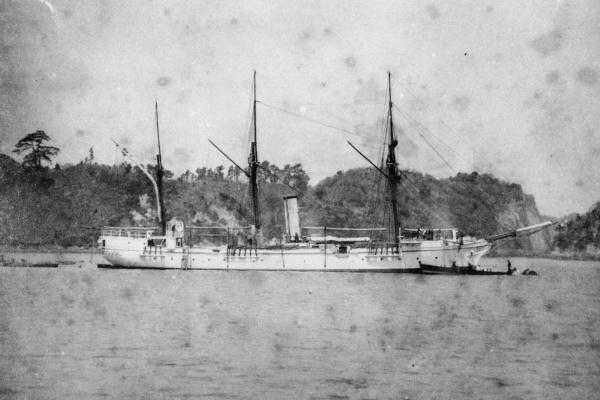
Built at Yokosuka, laid down on 2.1877, launched on 16.7.1878 she was completed on 7.1880. She was was the smallest of early pre-1st sino-Japanese war wooden-hulled vessels, and had a prominent poop. She was demoted and used as fishery protection from July 1907, and was stricken by May 1911.
Specs: 656/708t, 46.9 x 7.88 x 3.90, 1 shaft HC, 4 rectangular boilers 659hp, 10kts, 120t coal, armed with a 149mm/22 RKL/25 C/74, one 120mm/22 RKL/25 C/78, and two 79mm/25 RKL/27 C/73, crew 112. In the 1880s she also received three 4-barrelled 25mm/60 Nordenfelt Mk I repeating guns.
Maya class gunboats (1887-1890)
Class: Maya, Chokai, Atago, Akagi

Yes, these famous names were sported by Japanese gunboats in the 1880s, laid down 1885-86, launched 1886-87, cop. 1988-90. They looked like tiny cruisers, with a forecastle and poop, lower central battery, two masts, single funnel. They were rigged as schooners. All ordered under the 1882 Programme, and first two with iron hulls, remaining mixing iron and steel, fourth all steel and made by Onohama (Kobe) for the Maya and Akahi, Ishikawajima, Tokyo for Chokai and Yokosuka K K for Atago, with Akagi having a raised forecastle. They essentuially took part in the 1894 Sino-Japanese and 1905 Russo-Japanese wars.
Akagi received new 120mmm/40 Armstrong R, and four 47mm/40 3pdr Hotchkiss Mk I for the 1894 war (battle of Yalu) and by the late 1890s, Maya also got four 120mm/40 Armstrong R, and two 47mm/40 3pdr Hotchkiss Mk I. Fate became a fishery protection 5.1908, stricken 12.1911. Chokai was also demoted as a fishery protection vessel in 1908, and sold 1914, Atago was wrecked on 6.11.1904 SW of Port Arthur after running to a cliff in a fog and Akagi was stricken in 4.1911, likely retaining her role as gunboat. None saw WWI, let alone WW2.
Specs:
622t, 46.8 x 8.20 x 3.11m, 2x 2-cyl HCDA, 2 cyl. boilers 963 hp, 68-74t coal. Armament varied: 2x 149/mm22 RKL/25 C/74 or one 209mm/19 RKL/22 C/72, one 120mm/22 RKL/25 C/78, two 57mm/43 Nordenfelt Mk I, and two 25mm/60 Nordenfelt Mk I or four 120mm/32 Five Lille guns and four 47mm/40 3pdr Hotchkiss Mk I, plus the 25 mm Nordenfelt.
OSHIMA gunboat (1892)
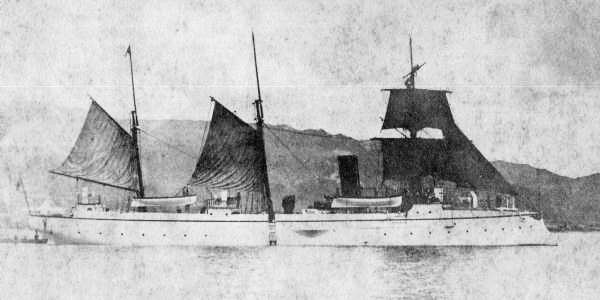
Ōshima was a small gunboat with three schooner masts, built at Onohama, Kobe, laid down on 8/1889, launched on 9/1891 and completed on 3/1892. She was the first Japanese ship with a Japanese VTE machinery, with a steel hull, pronounced ram, and some tumblehome as Emile Bertin was wruting the book on naval construction in Japan at the time. Secondary guns were placed at the forecastle and poop, and on sponsons amidships. Her original 32 cal. French Five Lille guns were replaced by 40 cal 120 mm or 4.7 inches Armstrong R guns. She took part in the first sino-Japanese war and was heavily damaged on 16 May 1904, colliding with the gunboat Akagi in the fog, NE of Port Arthur. She foundered after the flooding could not be stopped, on th 17th.
Specs:
640t, 53.7 x 8 x 2.75m, 2x VTE, 2 cyl. boilers, 1,200 hp, 13 kts, 140t coal. 30mm deck armour, four 120mm/32 Five Lille, 5x 47mm/40 3pdr Hotchkiss Mk I, single quintuple 11.4mm/94 MG. Crew 130.
SOKO gunboat (1879/1894)
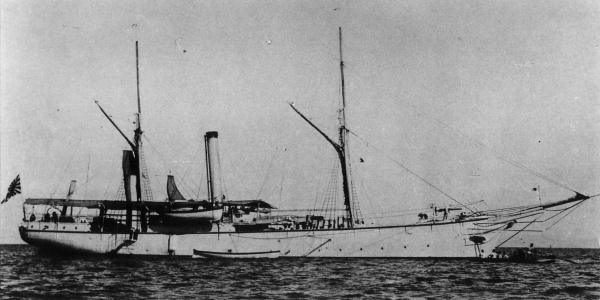
Soko was built at Kiangyan, Shanghai, China, lmaid down on February 1869 originally, launched in May 1869 and completed in July as a composite-hulled gunboat for the Nanyang fleet on British plans. She was captured during the 1st Sino Japanese war by the cruiser Akitsushima off the west coast of Korea on 25 July 1894 and renamed Soko, recommissioned on 12 September 1894, as and armed steamship. In 1898 she had her four 163mm/14 guns replaced by two 76mm/40 Armstrong N guns. By 1898 she was reclassified as a gunboat and survey vessel. On 21 March 1903 she ran aground and remained stranded in Nemuro Bay, so she was stricken by October 1903 but later refloated, and anchored as a permanent receiving vessel. In 1924 she was still used, now as the transport Sako Maru and was still around in… 1965. Some sources states she had been preserved.
CHINTO class gunboats (1889)
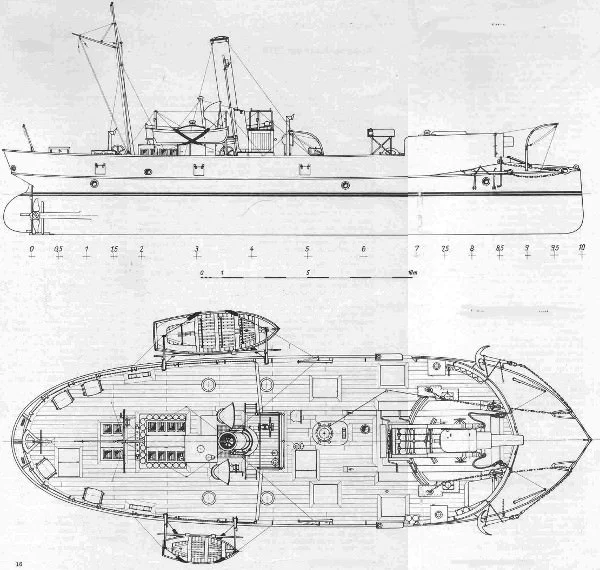
Ant-class for comparison. The Chinese ships were two-masts schonner rigged.
Class: Chinto (ex-Chen Tung, ex-Epsilon), Chinsei (ex-Chen Hsi, ex-Zeta), Chinna] (ex-Chen Nan, ex-Eta), Chimpen (ex-Chen Pien, ex-Theta).
These were British built 400/490t in 1878-1879 (Armstrong Mitchell, Low Walker) Steel-hulled Rendel flatiron gunboats for the Beiyang fleet. They were captured by the Japanese at Wei-Hai-Wei and impressed under Greek named at first, then under “Chin” names. Never modernized, they were stricken in 1906-1908 but Chinsei that became a training ship for the Japanese merchant navy. Fate unknown. They had a typical armoured bulwark and single heavy gun, a 279mm/23 Armstrong 35-ton MLR completed by two 76mm/19 12pdr 8cwt Armstrong BLR and two 10-barrel 11.4mm/94 Gatling MGs.
CHINCHU class gunboats (1881/1895)
Same story there, Chinchu was the ex-Chen Chung, ex-Iota from Armstrong Mitchell, Low Walke (launched 1880) and Chimpen the ex-Chen Pien, ex-Kappa. They were larger at 440/500t, same armament but two 102mm or 4-in/25 BL Mk I instead of their 3-in. Served briefly with the Beiyang fleet. Both captured at Wei-Hai-Wei and both stricken in 1906.
Other pre-WWI Gunboats
In WWI, Japan had virtually none of the gunboats seen above left. Older even were the Chiyodogata (1863), virtually the first warship ever built in Japan. She was sold in 1888. Nor werre the Taibo class (Dai ichi, Dai Ni) of 1867, scrapped 1885, Moshun (1865), Hosho (1868), and Banjo seen above were all discarded preior to WWI. Raiden (1856) was the former Royal Yacht HMS Emperor, presented to the Shogun by Queen Victoria in 1956, she took part in the Boshin war and was scrapped in 1888.
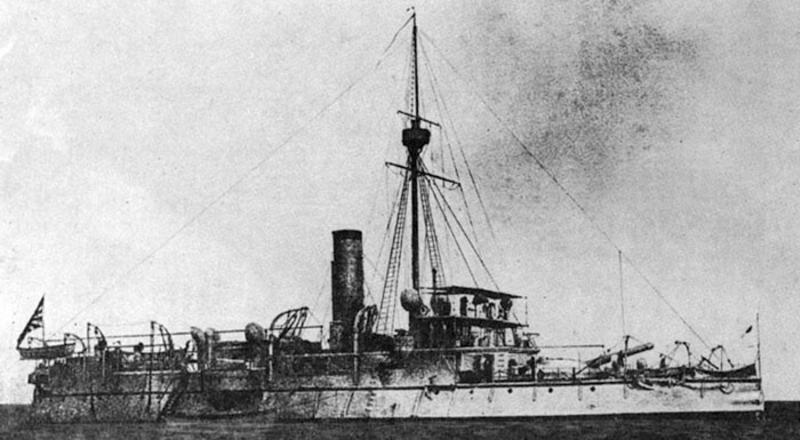
The IJN Heien or Hei Yen. She was the Chinese gunboat Ping Yuen Go (1895) captured on 17 February 1895, she served for about ten years, until the Sino-Japanese war, struck a mined off Pigeon Bay (Piegen Bay) west of Port Arthur on 18 September 1904 and sank with all hands.
Demoted cruisers such as the old unprotected Tsukushi (1880) was scrapped prior to 1914, the Kastsuragi class corvettes (1885) still had the Musashi and Yamato (yes, these names) around in 1914. Both since 1907 served as guard ships, and Yamato was used as a drill ship in Kobe by 1932, and while Musashi was scrapped in 1931 she was stil around in 1945. IJN Takao, a 1888 Bertin designed 1750t light cruiser was no longer active in 1911, but a survey ship until 1918, then scrapped. Yaeyama after the Russo-Japanese war was used for experiments until scrapped in 1911. Chishima was lost in 1896, Tatsuta (1894) became Nagaura Maru in 1918 and was a submarine repair ship in 1926, scrapped. Miyako (1898) was lost during the Russo-Jap war in 1904 (mine off Port Arthur), and Chihaya was stricken in 1927 and used as TS at Etajima naval academy until screeped in 1939. None served as gunboats.
China and the need for more gunboats
IJN Uji (1903) was truly the first “Chinese Gunboat”. As Japanese citizens and businesses were more presente in Korea and China, the IJN ordered a gunboat that was at the same time, shalow draught and capable of inter-island navigation if needed, while primarily a rivering warship able to protect Japanese Interests deep into China. See below for the full record.
The next one was Saga (1912), last prior to WWI and more of a sea-going/coastal than riverine vessel, although she had a 2.3 m draught to go deep inland via the yellow river. Next of this kind would be Ataka (1922) but she belongs to the interwar, see later.
There were also several riverine gunboats pre-WWI, such as Sumida, Fushimi, and Toba. Next was the Seta class in 1922, also see later. They consituted a solid base for development.
 UJI (1903)
UJI (1903)
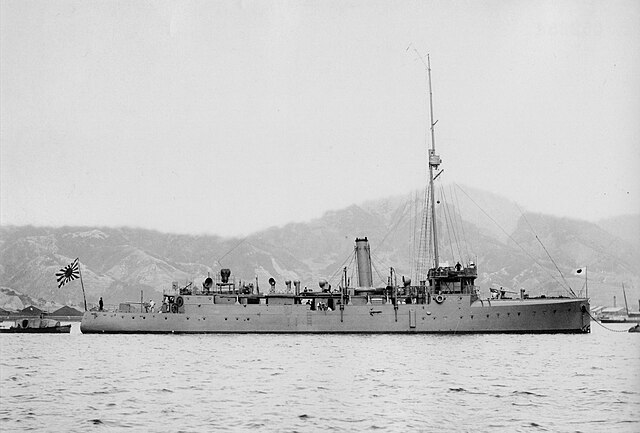
Uji was built under the 1896-1897 programme, intended for river and inshore operations thanks to her reduced draft, but still having enough freeboard to sail between Island, and so back to Japan. But she was mostly a costal vessel. Uji was built at Kure, as an all-steel but unarmoured gunbpat, completed in 1903. She did not took part in the Russo-Japanese war as she was intended as a colonial gunboat, mostly she served in Korea. But in 1914 she participated in the Tsingtao siege (German colony). She was stricken in 1932.
Specs:
620t, 57.8 x 8.41 x 2.13m, 2 shafts VTE, 2 Kampon boilers 1000 hp, 13 kts, 180t coal, four 76mm/40 Armstrong N guns and six 6.5mm MGs, crew 86 weapons for landing parties.
 SAGA (1912)
SAGA (1912)
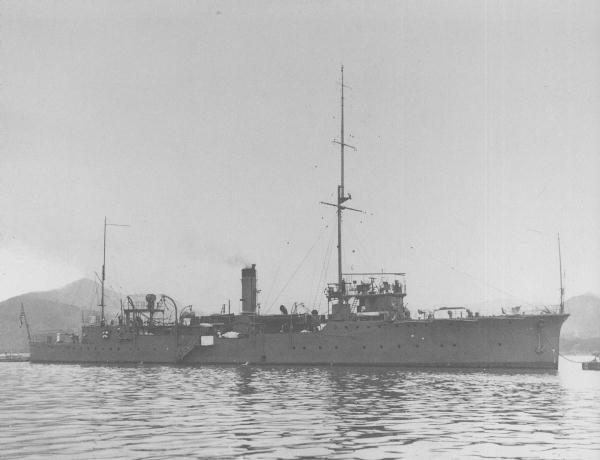
The last pre-WWI sea-going coastal gunboat. First class, all steel mae in Sasebo, with two masts, single funnel, a large gun on forecastle and two small guns amidships. Shje was the first Gunboat tailored for service in Chinese waters, derived from the 1st class gunboat Uji with increased dispensions and better armament and she had an unusual triple-shaft machinery for redundancy. She had a long career which ended in WW2. During World War I, she followed the fleet to Shandong Province, and took part in the Siege of Tsingtao. Next she was transferred to the Japanese Second Fleet and used for patrols in the South China Sea.
In September 1924, she was under the Japanese First Fleet and her captain was Commander Chūichi Nagumo (yes, this one) from 20 March 1926 to 15 October 1926. She was in the third Fleet from June 1931, 11th Sentai in October 1937, after the Marco Polo Bridge Incident, seeing action in the 2nd Sino-Japanese War.
From 15 December 1938 to 20 October 1939 under Tamotsu Oishi she wontinued her riverine patrols and by November 1939, she took part in the Second China Expeditionary Fleet in southern China. In 1941 she was modernized, with her three 76mm and 6.5mm MGs replacved by new 76mm/40 Type 11 and six 7.7mm/80 MGs.
In December 1941 she was in Guangdong. She was assigned to the Japanese invasion force to Hong Kong, and was stationed there untik stricking a sea mine on 26 September 1944. She was later refloated and towed back to Hong Kong for repairs but they were never complated and by 22 January 1945, she was blasted by an air raid (14th AF B-24 Liberators) and struck on 20 March 1945.
Specs:

785/885t, 69 x 8.99 x 2.21m, 3 shafts VTE, 2 Kampon boilers, 1,600 hp, 15 kts, 190t coal. She was armed with a single 120mm/45 type 3 forward, and three 76mm/40 type 41 as well as three dismountable 6.5mm MGs. crew 98.
 SUMIDA (1906)
SUMIDA (1906)
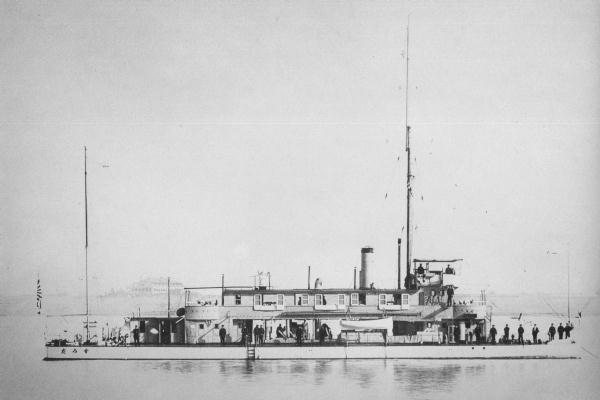
Sumida was the first of three riverine gunboats, first of dedicated boats intended for service on China rivers, and built under the 1896-1897 programme. Sumida was from Britain’s Thornycroft, Chiswick yard but shipped in parts and assembled in Japan from ready sections, from October 1903 to March 1906. Indeed, she had been launched in June 1903, but brought to Shanghai for final fitting out, when work was halted due to the enforcement of official British neutrality in the Russo-Japanese War. So she stayed unfinished until the end of the war and was finally commissioned as 2nd class gunboat on June 17, 1906. She remained based at the International Settlement in Shanghai and her weaponry was placed under lock in 1914, freed when China joined the Allies.
She saw action in the Second Sino-Japanese War, notably during the First Shanghai Incident in 1931 and operated on the Yangtze River until struck on March 1, 1935, scrapped in Shanghai.
Specs:
126t, 44.2 x 7.19 x 0.58m, 3 shafts VTE, Thornycroft boilers, 550hp, 13 kts, 40t coal, 2x 47mm/40 3pdr Hotchkiss Mk I, 4x MGs, crew 40. Never modernized.
 FUSHIMI (1906)
FUSHIMI (1906)

Same origin as above, she was built at Yarrow, Scotstoun, and intended for service on China under the 1896-1897 program, assembled from ready sections from October, 1906, so after the Russo-Japanese war at Kawasaki, Shanghai, completed in December. Se was much larger than Uji and more capable, still classed ans 2nd rate, but faster. Not armoured, she received armoured panels to be fitted as shutters on all windows if needed. She also had a large arsenal for a landing party.
Fushimi remained based at the International Settlement in Shanghai and was able to reach the three Gorges and upper Yangtze River, first to stop in Chongqing by April, 1907.
During World War I neutrality of China had her weaponry under lock in 1914 until China joined the Allies. She was active in the Second Sino-Japanese War, First Shanghai Incident in 1931 and operated on the Yangtze until considered obsolete, struck on March 1, 1935; scrapped at Shanghai.
Specs:
180t, 48.7 x 7.39 x 0.69m, 2 shafts VTE, 2 Yarrow boiler 900 hp, 14 kts, 25t coal,, 2x 57m/40 6pdr Hotchkiss Mk I, 3 MGs, crew 45.
 TOBA (1911)
TOBA (1911)
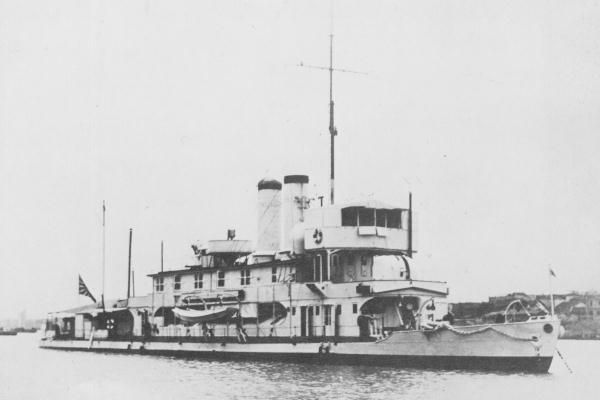
Toba was intended as a replacement for the Sumida and Fushimi and be present in inland waterways, order voted under the 1910 fiscal year budget. She was built in Japan, laid down at Sasebo Naval Arsenal on 7 July 1911, launched on 7 November 1911, commissioned on 17 November 1911. Still modeled after British predecessors, with slightly larger dimensions, more powerful engines to goin against the stronger currents inland. Her initial armament comprised two 3-in/23 model 41 and six MGs on pintles, but in later upgraded to 3-in/40 and in 1935 76/40 type 11. In 1940 her MGs were remoed ad replaced by three 25mm/60 type 96 AA guns and a single 13.2mm/76 HMG Type 93.
The Xinhai Revolution in China started in 1911, and Toba was sent immediately on completion with the cruiser Kasagi as part of the China Area Fleet. She was transported in a floating dry dock to Shanghai and assigned to patrols of the Yangtze from Shanghai to the Three Gorges to protect Japanese nationals and interests. Like the others for nautrality in 1914 her armamaent was under lock. She was reassigned to the Japanese 1st Fleet in 1919, 3rd Fleet in 1933 and modernized in Kure in April-June 1937 whith a larger beam from 8.99 to 9.78 meters to keep stability, and a 12 cm/45 10th Year Type naval gun, two 76 mm/40 guns, and two 7.7 mm MGs, two 76 mm/40 AA guns, two twin 13.2 mm (0.52 in), one depth charge thrower.
From July 1937, she was in Shanghai, Yichang based, Hubei Province, for the evacuation of 20,000 Japanese civilian residents during the Battle. She took part in the Battle of Madang on 26 June 1938, assisting the minelayers Nasami, Natsushima and Tsubame, shalling Chinese positions and minesweeping.
From 8 December 1941, Toba co-sank HMS Peterel and helped capture USS Wake (PR-3). She patrolled the Yangzi River from 1942 to 1945, with regular overhauls at Jiangnan Shipyard, Shanghai. She was Abandoned in Shanghai by September 1945, captured by the Republic of China, incorporated as Yong Ji, fighting agains the against communists in Haoxue (Jiangling County) ands renamed after the city on 17 April 1948, then captured and recommissioned in the PLAN on 29 November 1949 as Xiang Jiang, scrapped eventually in the 1960s. Quite a career indeed.
Interwar context:
1st Shanghai Incident:
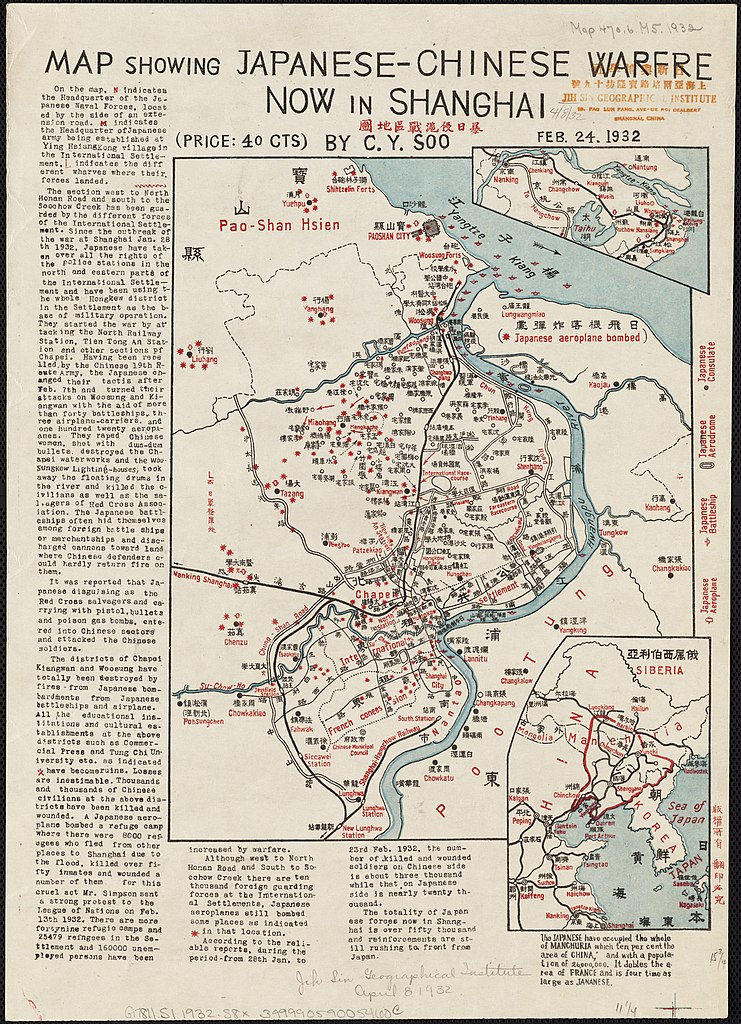
The 1931 Shanghai Incident, also known as the January 28 Incident, was a conflict between the Republic of China and the Empire of Japan that took place in Shanghai, China. The incident occurred during a period of increased Japanese aggression in China. The Japanese had already established significant economic and political influence in parts of China, especially in Manchuria. The Japanese invasion of Manchuria in September 1931 had escalated tensions between China and Japan. This invasion led to the establishment of the puppet state of Manchukuo. On January 28, 1932, fighting broke out between Chinese and Japanese forces in Shanghai. The conflict began after a series of provocations and skirmishes. The Japanese military launched a large-scale attack on Shanghai, using their navy, army, and air force. The Japanese aimed to secure their interests in the region and to weaken Chinese resistance.
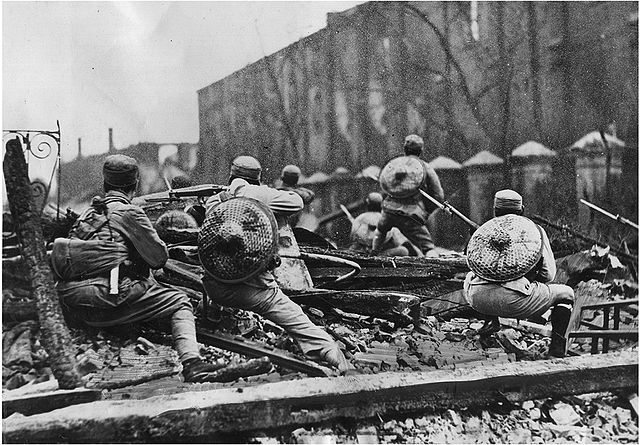
Chinese 19th Route soldiers in a defensive position.
Chinese forces, including the 19th Route Army and local volunteers, put up a determined resistance against the better-equipped Japanese forces.
Shanghai had a significant foreign presence due to the International Settlement, a foreign-controlled area in the city. This led to international concerns and calls for mediation.
The League of Nations intervened, leading to a ceasefire brokered on March 3, 1932. The incident highlighted the limitations of the League in managing conflicts involving major powers.
The incident fueled anti-Japanese sentiment in China and contributed to the rise of Chinese nationalism. It was also laregely seen as a prelude to Full-Scale War: The Shanghai Incident was one of the precursors to the Second Sino-Japanese War, which began in 1937 following further Japanese aggression.
Marco Polo Bridge incident and Mandchurian invasion
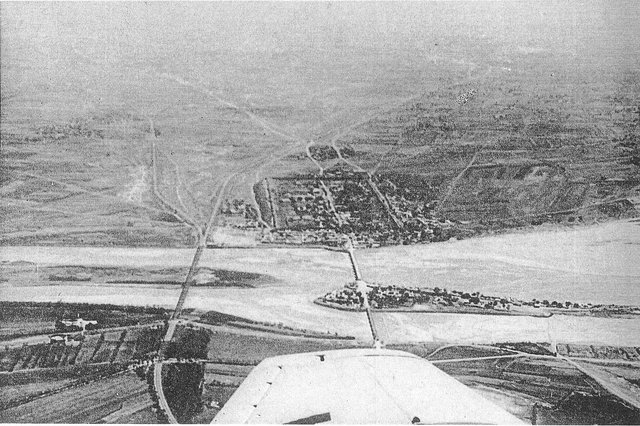
The Lugou Bridge Incident was a crucial event that led to the full-scale outbreak of the Second Sino-Japanese War. It occurred in a context of rising tensions between China and Japan, following years of Japanese expansionist policies and military incursions into Chinese territory. It took place near the Marco Polo Bridge (Lugou Bridge), located about 15 kilometers southwest of Beijing (then known as Beiping) in the night of July 7, 1937. It started with a skirmish between Chinese and Japanese troops stationed near the bridge. The Japanese claimed that one of their soldiers had gone missing and demanded entry into the nearby town of Wanping to search for him. The Chinese garrison refused. The situation quickly escalated into an exchange of gunfire. Despite attempts at negotiation, the confrontation intensified, with both sides reinforcing their positions.
In the following days, the Japanese launched a full-scale assault on the Chinese forces around the bridge and in the Beijing-Tianjin area. This marked the beginning of a wider campaign. The Chinese Nationalist government, led by Chiang Kai-shek, decided to resist the Japanese aggression, leading to a broader mobilization of Chinese forces.
It is widely regarded as the starting point of the Second Sino-Japanese War, spreading beyond the Beijing-Tianjin area to other parts of China. The incident and subsequent war galvanized Chinese resistance against Japanese aggression, leading to significant contributions from both the Nationalist government and Communist forces led by Mao Zedong.
The incident drew international attention and condemnation, highlighting Japan’s aggressive military policies. The League of Nations was unable to effectively intervene or prevent the escalation of the conflict.
Operations
Japanese riverine operations in China were a critical component of their military strategy during the Second Sino-Japanese War (1937-1945). These operations involved the use of naval and amphibious forces to control and exploit China’s extensive river systems, particularly the Yangtze River, to facilitate the movement of troops, supplies, and to exert control over key regions. China’s river systems, especially the Yangtze River, provided vital transportation routes deep into the country. Controlling these rivers allowed the Japanese to penetrate inland regions that were otherwise difficult to access. The rivers were crucial for transporting goods and resources. By controlling these waterways, Japan aimed to disrupt Chinese logistics and supply lines while ensuring their own supply routes.
Yangtze River Campaign:
Battle of Shanghai (1937): Japanese forces used riverine operations to support their land assault on Shanghai. Naval gunfire and troop landings along the riverbanks were instrumental in capturing the city.
Capture of Nanking (1937): Following the fall of Shanghai, Japanese forces advanced up the Yangtze River to capture Nanking (Nanjing), the then-capital of China. Riverine units provided essential support in transporting troops and supplies, as well as engaging Chinese defenses along the river.
Amphibious Landings and River Patrols:
Hankou Campaign (1938): Japanese forces conducted extensive riverine operations to capture Hankou (part of modern-day Wuhan). They used gunboats, troop transports, and barges to move forces up the Yangtze River, bypassing heavily fortified positions along the land routes.
The Patrol war: Throughout the war, Japanese naval forces patrolled the major rivers, enforcing blockades, conducting reconnaissance, and ensuring the security of their supply lines. They established riverine bases and deployed small craft to maintain control over occupied regions.
Tactics and Technology: Japanese used both Gunboats and Naval Infantry on a variety of riverine vessels, including gunboats equipped with artillery and machine guns. These vessels supported infantry operations, provided fire support, and transported troops. Riverine operations were supported by a network of supply depots, repair facilities, and communication posts along the rivers. This infrastructure enabled sustained military operations deep within Chinese territory.
Chinese forces employed guerrilla tactics and sabotage to disrupt Japanese riverine operations. They targeted Japanese vessels and supply lines, complicating the occupation efforts.
Navigating China’s rivers posed significant challenges due to seasonal variations, shallow waters, and narrow channels. The Japanese had to overcome these obstacles to maintain effective control and mobility.
Riverine operations provided Japan with a strategic advantage, allowing rapid movement of forces and contributing to the capture of key Chinese cities and regions. Despite initial successes, maintaining control over the vast and diverse Chinese territory proved difficult. Chinese resistance, coupled with the logistical strain of prolonged riverine operations, eventually weakened Japanese control. The use of riverine operations in China demonstrated the importance of integrated naval and land strategies in modern warfare, influencing subsequent military doctrines and amphibious operations during World War II and beyond.
Why no Chinese vs Japanese gunboats ?
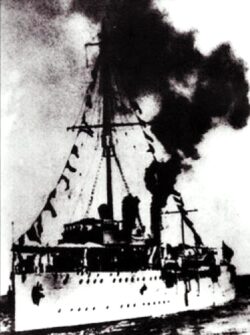 The Chinese navy prior to the 1937 second Sino-Japanese war was well provided with gunboats, often better than the few obsolete cruisers still in service. Japan only had a handful of gunbpoats, poorly armed and took no chances. There was an all-out assault and hunt for all Chinese gunboats present, they were all sunk in a matter of days in 1937 and all along the year and up to 1938. So after this, many were captured, helped the fact they sank in shallow waters, and Japanese Gunboats had basically free range on all waterways. from 1940 lighter gunboats with very shalow draft entered service to roam any possible corner of inland China. Photo: Zhongshan of the Yongfeng-class gunboats, built in japan in 1910.
The Chinese navy prior to the 1937 second Sino-Japanese war was well provided with gunboats, often better than the few obsolete cruisers still in service. Japan only had a handful of gunbpoats, poorly armed and took no chances. There was an all-out assault and hunt for all Chinese gunboats present, they were all sunk in a matter of days in 1937 and all along the year and up to 1938. So after this, many were captured, helped the fact they sank in shallow waters, and Japanese Gunboats had basically free range on all waterways. from 1940 lighter gunboats with very shalow draft entered service to roam any possible corner of inland China. Photo: Zhongshan of the Yongfeng-class gunboats, built in japan in 1910.
Japan recaptured Zhongshan in 1937, as Admiral Shen scuttled his ships, including Yongxiang as blockships to removed the guns for Chinese field artillery. The Central Fleet retreated up the Yangtze while blocking the mouth near Jiangyin. Yongjian was refitting at Jiangnan Shipyard and sunk by IJN aviation on 25 August. Zhongshan, Yongji and others waited at Hankou to evacuate government officials to Chongqing and ended under constant air attack in the Battle of Wuhan. Yongji was beached on 21 October and Zhongshan was sunk on 24 October.
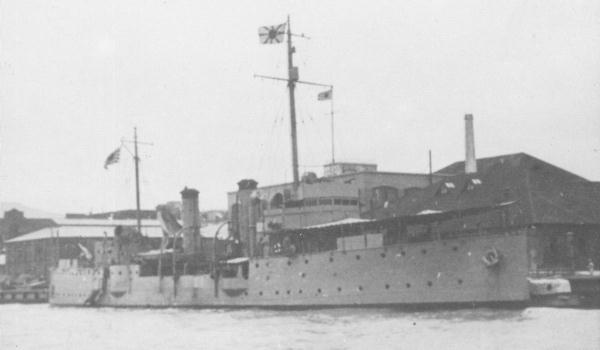
Yongxiang was raised at Qingdao and became the harbour ship Asuka (photo) at Shanghai, then converted as local AA ship in 1945, sunk by USN planes in the Huangpu River in May 1945. She was refloated and served with the Republic of China Navy as Hai Hsing, but she was sunk, then raised in 1997. Restoration was completed in 2001 and she is now on display at the Zhongshan Ship Museum.
Nomenclature of WW2 IJN Gunboats
Toba (1911), see above, WWI section. Toba served from 1911 to the 1960s.
Seta class (1913): 4
Ataka (1922)
Atami class (1928): 2
Saga (1932)
Hashidate class (1939): 2
Fushimi class (1939): 2
Kotaka (1940)
Captured gunboats Tarara, nanyo, Nankai, Okitsu, Karatsu, Shima, maiko, Barumi
 ATAKA (1923)
ATAKA (1923)
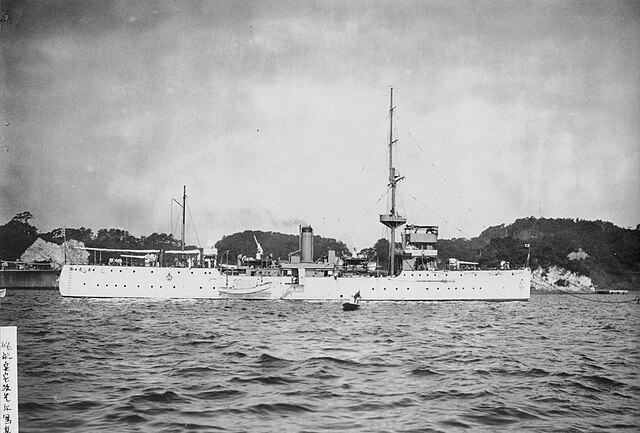
Ataka was built under the 1921-1928 programme, based on the previous 1st class Saga. She was also tailored to serve as submarine salvage vessel, with a proper equipment.
In July 1937 in Kure her foremast became a tripod, she had bulges fitted, beam was extended to 9.78 m, displacement to 866/1094 t and she had two 3-1in/40 Type 11, two twin 13.2mm/76 HMGs and one DCT installed.In 1939 she was given twi twin 13.2 mm Type 93 HMGs more. In 1940 some source sstates she obtained a radar.
On 20 May 1933 she was assigned to the 3rd Fleet, flagship of the 11th Gunboat Senta replaced by Yaeyama in 1937. She was Based in Shanghai during the Second Sino-Japanese War. In August, 1945 she surrendered to Allies and was transferred to the Republic of China Navy but defected to the PLAN in 1949, sunk in Wuhu by Nationalist aviation, 23 September.
Specs:
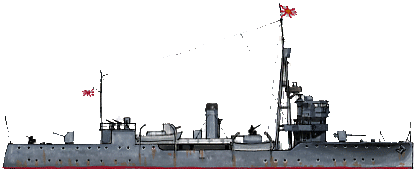
880/1133t, 71.7 x 8.99 x 2.26m, 2 shafts VTE, 2 Kampon boilers 1700 hp, 16 kts, 235t coal, 2x 120mm/45 type 3, 2x 76mm/40 type 3, 6 MGs, 118 crew.
 ATADA (training gunboat) (1930/1938)
ATADA (training gunboat) (1930/1938)
She was the Former Chinese gunboat Yat Sen (Kiangan Dock, China, laid down 1.1930, launched 12.11.1930), capsized, sunk 25.9.1937, after being bombed by aviation. Salvaged by the Japanese, repaired, re-entered service by May, 1938 as IJN Atada, used as training ship for Naval Academy. She was modernized with a new tripod mast and had a new extended bridge and cadet accomodation under her raised quarterdeck. Her WW2 career was unermarkable but in 1945 she was converted as a floating battery. For specs see the Chinese Navy 1930-45.
 HASHIDATE class gunboats (1940)
HASHIDATE class gunboats (1940)
Hashidate, Uji
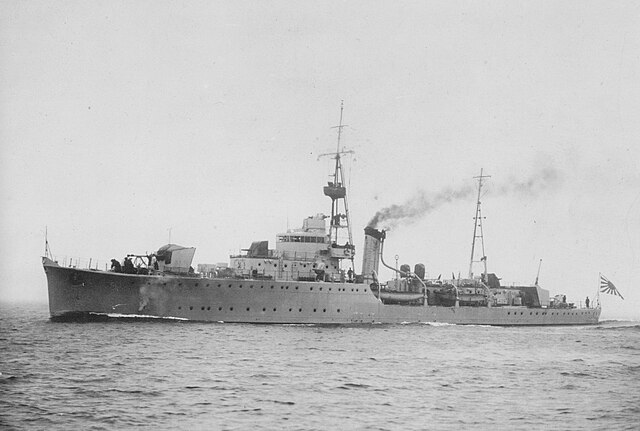
Hashidate and Uji were built under 3rd Supplementary programme of 1937 for inshore waters and river mouths in China with a shallow draught. In 1943-1944 both had two triple 25mm/60 Type 96 added and three single 25mm as well as two 2 DCT, and presumably a radar. Hashidate took part on 6 December 1941 to Operation “C” against Hong Kong attached to the 15th Escort Squadron. From April 1942 she served with the China Area Fleet’s Second China Expeditionary Fleet. In May 1944 she departed Hong Kong for Takao escorting convoy No. 88 (TSUKUBA MARU, SHINJU MARU and ATSURI GO MARU), and 22 May Off Pratas Island in South China Sea, 18:00 USS PICUDA (SS-382) while slowed down, towing the crippled passenger-cargo ship TSUKUBA MARU previous damaged on 20 May by 14th Air Force B-24s. The submarine fired four bow torpedoes and she probably took two hits, while TSUKUBA MARU is also hit but she would make it back to Hong Kong.
Uji on 30 April 1941 acted as flagship at the Yokosuka Naval District. She served from December 1941 to 20 August 1943 in the First China Expeditionary Fleet and then was attached to the Yangtze Base Force, China Area Fleet. She escorted a convoy on 21 April with Ataka and the “Take” convoy with destroyers, patrol vessels, minelayers and minesweepers, subchasers and troopships with the 32nd and 35th divisions from China via Manila to New Guinea. on 27 April 1944 she departed Takao with FUKUE and CD-2, escorting convoy TAMO-18. on 4 August 1944 she left Moji for Takao convoy MOTA-22 and troopships with the 25th Tank Regiment to Formosa. On 16 August 1944 she departed Woosung in China for Naha, Okinawa with 2 destroyers escorting convoy No. 609 and 6,000 troops of the 62nd Infantry Division, 900 horses for its Field Heavy Artillery. On 22 August 1944 off Ryukyu Islands she is ambusged by Cdr John Corbus’ USS BOWFIN (SS-287) which sinks TSUSHIMA MARU but neither UJI and HASU counter-attack on orders. Uji was badly damaged on 10 March 1945 by a mine, never repaired, she was surrendered to the Allies in Shanghai by August 1945 and transferred to Republican China as Chang Chi, fate unknown.
Specs:

999/1110t, 80.5 x 9.70 x 2.45, 2 shafts geared steam turbines, 2 Kampon boilers, 4600 hp, 19.5 kts, 3,460 nm/14 kts, Twin+single 120mm/45 type 10, 2 twin 25mm/60 Type 96, crew 170.
 Captured Gunboats
Captured Gunboats

IJN Tatara, ex USS Wake, ex-Guam (1927).

IJN Karatsu, ex-Luzon which served in the Philippines.
NANYO (1943):
Ex-Lyemun, ex-Looe, former British minesweeper of the Bangor class, captured in construction in Hong Kong, comp. March 1943, sunk 23 December.
NANKAI class (1944):
Former Dutch minelayers Ram and Regulus (laid down 1941), one scuttled incomplete Tjilajap on 2 March 1942, raised renamed Nanshin, converted as gunboat but never completed. Sister-ship Regulus was capture in dock, Surabaya. Completed, commissioned as the gunboat Nankai. She had two twin 120mm/45 Type 10, two twin 25mm/60 Type 96, 4 DCT and mines plus a radar Type 3, 1-go.
Specs: 2400t, 85.8 x 11 x 3.80, 2 shafts diesels 4800 bhp 18 kts, crew 120
OKITSU (1944):
She was the former Italian minelayer Lepanto, scuttled at Shanghai on 9.9.1943 (after the armistice so). In February 1944 she was salvaged and recom. by March as gunboat. She had a single 76mm/40 Type 11 DP gun, four twin 25mm/60 Type 96, 2 DCT and 2 DCR (36) plus a Type 3 radar. On 21 March 1945 she was badly damaged by US aviation and by August, she surrendered to Allies, was transferred to China as Hsien Ning.
ASUGA (AA ship, 1915, conv. 1945):
The Former Chinese gunboat Yung Chien, captured in 1937 and renamed Asuga, she entered service as launches depot ship and from 1940 based in Shanghai.
In 1945 she was was reclassified to AA floating battery. She was sunk on 7 May 1945 after an US air raid and later salvaged and transferred to China as Yen An.
TATARA (1941)
Se was the USN river gunboat Wake, captured in Shanghai 8.12.1941 by the IJN. She was standardized and recommissioned on the 15th as Tatara. In 1944-1945 she lost her ten 7.7mm/80 MGs for thirteen single 25mm/60 Type 96 AA guns. In 1945 she was transferred to the ROCN in Shanghai as Tai Yuan.
KARATSU (1942)
Also built at Kiangnan Dock, Shanghai, China like USS Wake, she was the ex-Luzon, scuttled at Corregidor on 6 May 1942, salvaged and repaired, recommissioned in august 1942 as IJN Karatsu. She stayed in the Philippines waters, and on 3 March 1944 was was badly damaged by gunfire by the cruiser submarine USS Narwhal, and later sank back at Manila.
SUMA (1942)
She was the ex-Insect class HMS Moth scuttled on 12 Dec. 1941 at Hong Kong, salvaged, repaired, recommissioned by July 1942 as Suma. She served in China, sunk 19 March 1945 after hitting a mine near Kiangying on the Yangtze.
MAIKO (1943)
Portuguese river gunboat “Macau” (Yarrow, Scotstoun 1909), captured by Japanese in 1943, recommissioned on 15 August 1943 with her nama Japanized as Maiko. She surrendered at Canton in August, 1945 and was transferred to China as Wu Feng, fate unknown.
NARUMI (1943)
Italian river gunboat Ermanno Carlotto (Shanghai Dock, China 1918-21), scuttled by her crew on 9 Sept. 1943 in Shanghai, salvaged repaired as Narumi, 15 October 1943. Badly damaged on 15 Jan 1945 by US Army aircraft near Hankow. Never repaired, disarmed in 1945 for the guns to be used ashore. She surrendered in August 1945, transferred to ROCN 1946 as Kiang Kun.
 SETA class gunboats (1923)
SETA class gunboats (1923)
Seta, Kataka, Hira, Hozu
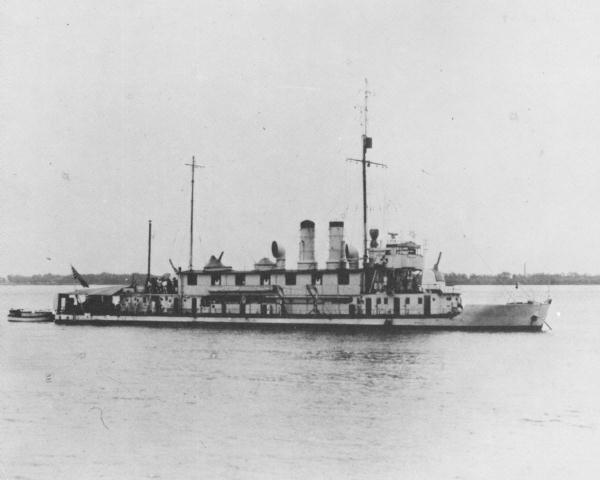
All four were purpose built riverine gunboats two built at Harima Zosen/Tunghwa SB in Shanghai in 1922-23 and two at Mitsubishi, Kobe/Yangtze Eng. Co, Hankow. All built in China for service on Chinese rivers and they resembled predeccessors, under the 1921-1928 programme. They patrolled the major rovers and made the bulk of heavy duty riverine patrols in the interwar and WW2. In 1940, all received 76mm/40 Type 11 DP guns and six 25mm/60 Type 96 AA guns, and in 1945 for those which survived, they had five 13.2mm/76 Type 93 AA HMGs.
Seta surrendered in August 1945, transferred to China as Chang Teh.
Kataka wa sbadly damaged oon 18 Dec. 1944, by US aviaton, again in March 1945, never repaired. She surrendered in August 1945, and she was BU in 1946.
Hira was badly damaged on 26 August 1944 and never repaired, just like Hozu after a Chinese air raid.
Specs:
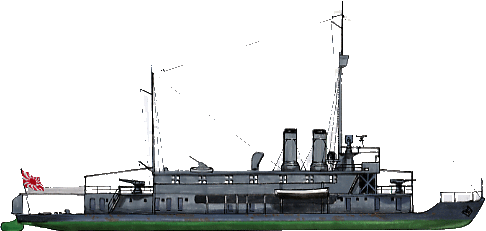
338/400t, 56.1 x 8.23 x 1.02m, 2 shafts 2-cyl VC, 2 Kampon boilers, 2,100 hp 16 kts, 74t coal, 25t oil, 1750 nm/10 kts, armed with two 76mm/40 type 3, 6 MGs. Crew 62.
 ATAMI class (1929)
ATAMI class (1929)
Atami, Futami
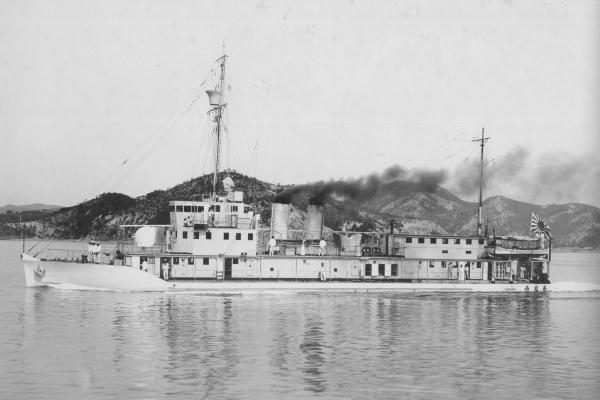
River gunboats for Chin built at Fujinagata, Osaka in 1928-30 and close to their predeccessors under the 1923 programme.
Atami was part of the 11th Gunboat Sentai on the Yangtze River and took part in the Second Sino-Japanese War. Post WW2, she was transferred to the ROCN as Yong Ping and captured by the Chinese communists in 1949, PLAN Wu Jiang, scrapped 1960s.
Futami like her sister was delivered from Japan broken down into sections, shipped for reassembly in Shanghai. She patorlled the Yangtze River up to the Three Gorges. On 14 June 1933, she ran aground on uncharted rocks. In Hankou by 1937 she operated bombardments with the minelayer Yaeyama, Katata and Hozu for the 292 marines SNLF. From February to May 1939 she took part in the Battle of Nanchang under command of the 1st China Expeditionary Fleet. She stayed in Hankou and was stricken 30 September 1945. Transferred as Yung An and PLAN 30 November 1949 as Zhu Jiang, scrapped in the 1960s.
Specs:
206/249t, 46.3 x 6.30 x 0.92m, 2 shafts 2-cyl compound VE, 2 Kampon boilers, 1,300 hp 16.7 kts, fuel oil 53t. One 76mm/23 Type 41, one 13.2mm/76 Type 93, 5 MGs crew 77.
 KOTAKA (1930)
KOTAKA (1930)
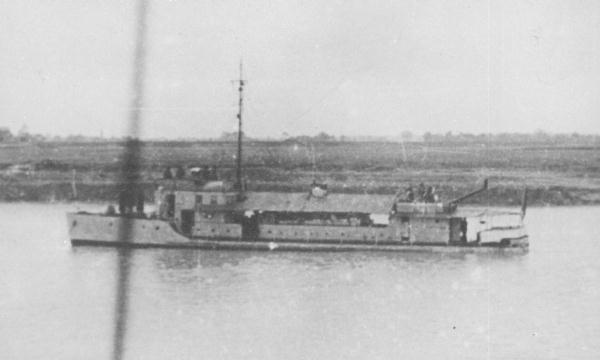
Kotaka was a river gunboat built in 1930 at Mitsui, Tamano, under the 1927 programme for the Upper Yangtze so with a very shallow draught, carried to China on the deck of a cargo vessel.
She was part of the 11th Gunboat Sentai and during the war, she was used as passenger and communications ship. She took part in the Battle of Wuhan, Battle of Madang, then Battle of Jiujiang in 1938. From February to May 1939 she took part in the Nanchang Campaign. She was sunk on May 31, 1944 on the Yangtze when used as communications ship.
Specs:
50/63t 30.5 x 4.90 x 0.64m, 2 shafts diesels 540 bhp 15.5 kts, 5x MGs.
 FUSHIMI class (1939)
FUSHIMI class (1939)
Fushimi, Sumida
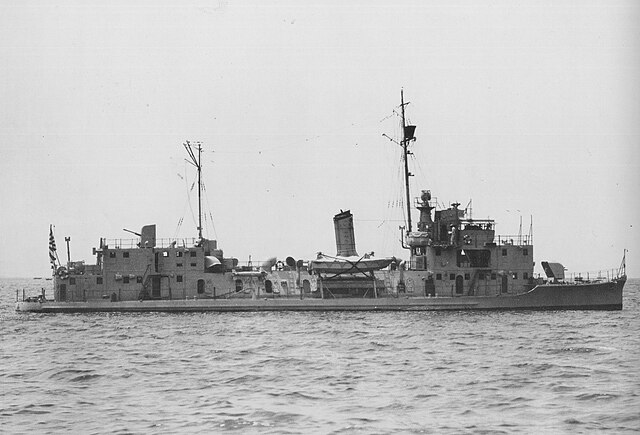
Two 3rd Supplementary programme 1937 gunboats for Chinese Rivers, built at Fujinagata, Osaka in 1938-39. They were the very last IJN rivering gunboats. Two more, N°868 and 869), were provisioned in the 1942 programme but never laid down. In 1942-43 they were both modernized with the addition of a 76mm/40 Type 11 and three twin 25mm/60 Type 96 AA guns.
Fushimi was assigned to the Yokosuka Naval District, then 1st China Expeditionary Fleet and was capable of sailing to Shanghai on 15 November. From 1 April 1940 to 21 June, she patrolled the middle Yangtze River from Hankou and until April 1941, the middle Yangtze up to Hankou. From October 1941 she was based at Nanjing and by 8 December she was flagship for Vice Admiral Prince Teruhisa Komatsu 1stt China Fleet Yangtze Squadron and Upper River Division. After a July 1942 overhaul in Shanghai, she was reassigned to the Middle River Division in Hankou and from 4 September 1943, the Lower River Division and Tung Ting Lake from 10 November. On 29 November 1944 she was atacked by Chinese aircraft, sunk near Anqing. Refloated she sas disarmed on 10 January 1945 to profit the land-based defenses and remained docked at Shanghai, transferred to ROCN 1945 as Chiang Feng, captured by PLAN.
Sumida was in the 1st China Expeditionary Fleet from 17 June, lower Yangtze River 1940, middle Yangtze 1941, upper Yangtze in 1942, Tung Ting Lake force, and took part in “Operation SE”. Badly damaged in an Chinese air raid, captain and 11 crewmen killed. Repaired in Shanghai, lower Yangtze, middle Yangtze and badly damaged by air raid on 22 June 1944 at Hankou, and on 25 November. Postwar, recom. as ROCN Chiang Hsi, captured by PLAN 30 November 1949, Fu Jiang, scrapped 1960s.
Specs:
304/368t, 50.3 x 9.78 x 1.26m, 2 shafts geared steam turbines, 2 Kampon boilers, 2200 hp 17 kts, 1500 nm/14 kts. One 76mm/23 Type 41, twin 25mm/, 2 MGs, crew 64.
 “H” type gun boat
“H” type gun boat
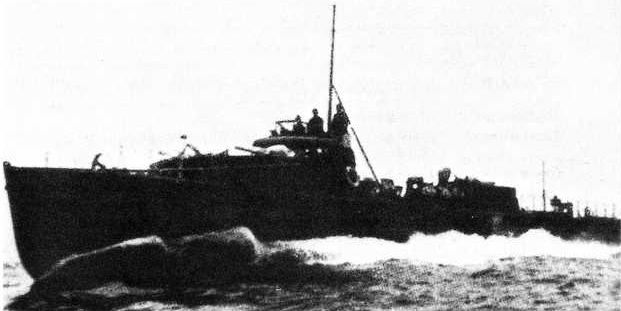
Baglietto type motor boats, without torpedoes, used for coastal patrol and too small and afst to be considered as “gunboats”. The first displaced 26t, 33 kts, armed with two 20mm/65 Type 98, 2x LMGs and DCR. They werte escort launches for inter-island service basically. The “class” is distinguished between the H1-H2 (9), H-35/38 (11+65), and the H-61 class (105). Named given officially were 1-GO, 2-GO (H2 class) in 1943, 27-GO (H35) and 10-GO (H38) then 74-GO for the H38M type in(1944 and mastly 33-GO for the “H61” type in 1944-1945. They will be seen more in detail in the future IJN motor boats page in redaction.
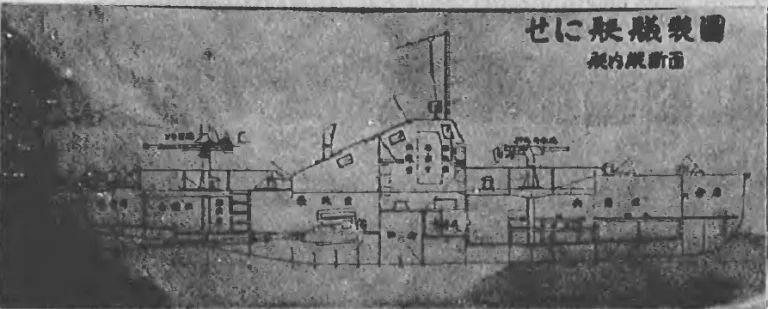
 Soukoutei-class armored boats (1928-1945): 56 made
Soukoutei-class armored boats (1928-1945): 56 made
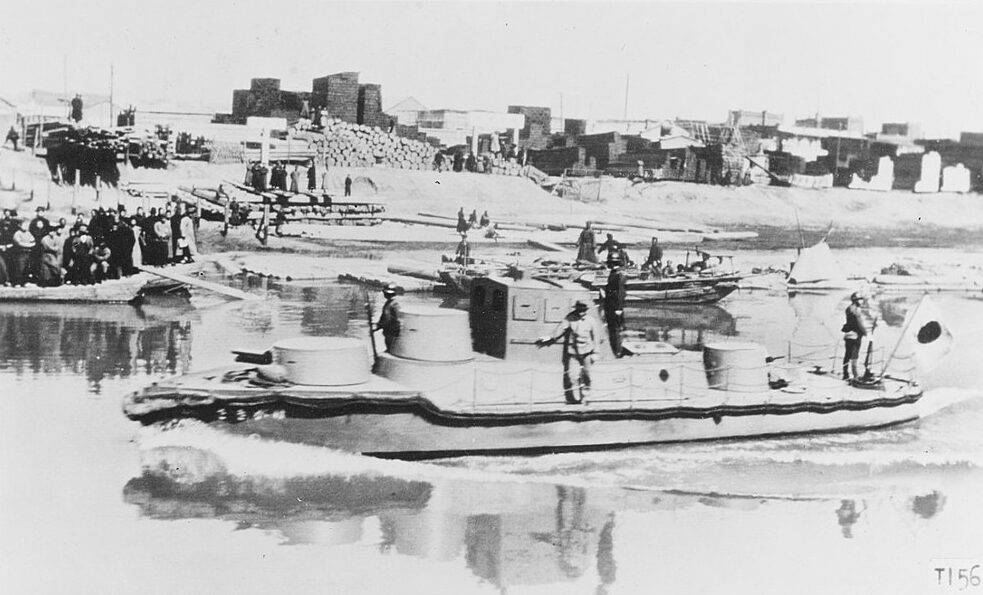
The Soukoutei class (装甲艇 “armored boat”) or “AB-tei” class were Imperial Japanese Army armored boats in service from from 1928 to 1945, made of a metal hull, powered by a truck type diesel engine and known as “Type C” landing craft by US intel. But they were not troopships, used for close support and escort.
Still, originally they were part of a complete suite of capabilities for amphibious assaults, and neither the Shohatsu, Daihatsu which were true landing craft, they also designed a communications boat, the 11-meter (36 ft) HB-O and a reconnaissance gunboat, 14.4-meter (47 ft) HB-K with an armored boat developed to provide close-in support. The prototype was completed in 1928 as the “Sakigake” of “Pioneer” at 14.4 meters for 16 tons with a gasoline engine and armed with two 6.5 mm Type 38 machine guns, one 37 mm “Sniper”, then a 1930 prototype “Kachidoki” (20 meters, 20 tons) running on diesel, armament upgraded to a 57 mm Type 90 tank gun, two 7.7 mm Type 89 on swivel. 1932 saw Kachidoki used in the landing at Shanghai (January 28 incident).
The third was down to 15.5 meters, 17.5 tons, same armament and this Armored Boat No. 3 was chosen for production in 1933, with 23 more built (AB-4 to AB-26).

Japanese Soukoutei class/AB-tei class armored boat (front) with other boats at dock in Tianjin, ca. 1930-1939 (reddit)
In 1937 it went to 17.5 meters (57 ft), 20 tons, 14 knots, ten built. In 1938, it reached 16.5 meters (54 ft), 20 tons, two 57 mm tank guns, eleven built. 1939, down to 16.5 tons one 57 mm gun removed, 19 boats made. These were no longer used for amphibious operations in 1943, and after the Battle of the Bismarck Sea in March 1943 they started to supply their garrisons without large ships such as destroyers, taking way too more losses, but convoys of barges escorted by these tiny and unexpensive armored boats instead. A typical configuration was 1,000 men over 300 miles escorted by 2 armored boats for two Toku Daihatsu, 40 large landing barges (Daihatsu), 15 small landing barges (Shohatsu), but they were easy meat for PT-Boats and ultimately the Japanese designed their own fast torpedo or attack boats to counter them. So landing boats, no, gunboats certainly, with 56 made and nearly all lost in the Pacific, and some in China.
 ST-class armored boats (1940-1945): c50? made
ST-class armored boats (1940-1945): c50? made

The ST-class armored boats were pure riverine gunboats built en masse by Mitsubishi Heavy Industries Ltd. at their Yokohama Shipyard. They were tailored for riverine patrols in China. The ST-class were armored boat tailored for use by the Imperial Japanese Army, not the Navy (as most landing crafts), and the type was developed in 1940 for riverine patrol in China, replacing for this, the Soukoutei-class armored boat see above. The prototype was 11 meters long for 2 meters in beam, 1.10 m in draught, top speed 9.65 knots. Production was greenlight and went on at Yokohama shipyard, Mitsubishi Heavy Industrie. There was a single tank turret with a 37 mm gun turret borrowed from the very popular Mistubishi Type 95 Ha-Go. Production numbers remained ellusive. Conways has no data on these, since they belonged to the IJA, not the IJN.
Production boat specs: 11 x2 x 1.1m (36.09 ft x 6.56 ft x 3.61 ft). 150 hp Mitsubishi diesel, 9.65 knots (17.9 km/h), one 37 mm tank turret, armour c8 mm around the vitals, around the turret and small bridge forward of it.
Read More/Src
Books
Jentsura, Hansgeorg (1976). Warships of the Imperial Japanese Navy, 1869-1945. NIP
Nishida, Hiroshi. “Materials of IJN”. Imperial Japanese Navy.
Brown, David (1990). Warship Losses of World War Two. Naval Institute Press.
Brown, David (1990). Warship Losses of World War Two. Naval Institute Press.
Jentschura, Hansgeorg; Jung, Dieter & Mickel, Peter (1977). Warships of the Imperial Japanese Navy, 1869–1945. NIP
Sturton, Ian (1980). “Japan”. In Chesneau, Roger (ed.). Conway’s All the World’s Fighting Ships 1922–1946.
Links
http://www.ibiblio.org/pha/monos/144/144chap2.html#Shanghai%20Incident
http://www.combinedfleet.com/HashidateG_t.htm
http://www.combinedfleet.com/Uji_t.htm
http://admiral31.world.coocan.jp/e/stc0659.htm
https://www.navypedia.org/ships/japan/jap_other.htm
https://www.navypedia.org/ships/japan/jap_boats.htm
https://www.navypedia.org/ships/japan/jap_escorts.htm
https://en.wikipedia.org/wiki/ST-class_armored_boat

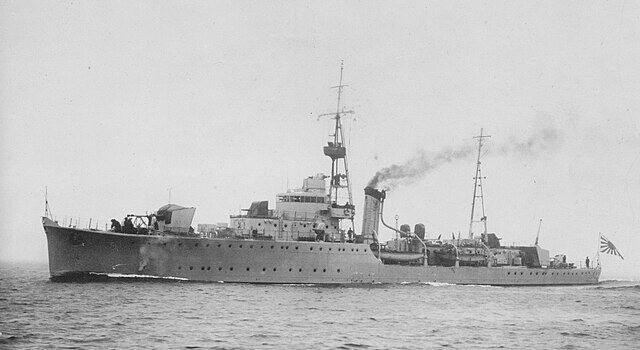

 Latest Facebook Entry -
Latest Facebook Entry -  X(Tweeter) Naval Encyclopedia's deck archive
X(Tweeter) Naval Encyclopedia's deck archive Instagram (@navalencyc)
Instagram (@navalencyc)





 French Navy
French Navy Royal Navy
Royal Navy Russian Navy
Russian Navy Armada Espanola
Armada Espanola Austrian Navy
Austrian Navy K.u.K. Kriegsmarine
K.u.K. Kriegsmarine Dansk Marine
Dansk Marine Nautiko Hellenon
Nautiko Hellenon Koninklije Marine 1870
Koninklije Marine 1870 Marinha do Brasil
Marinha do Brasil Osmanlı Donanması
Osmanlı Donanması Marina Do Peru
Marina Do Peru Marinha do Portugal
Marinha do Portugal Regia Marina 1870
Regia Marina 1870 Nihhon Kaigun 1870
Nihhon Kaigun 1870 Preußische Marine 1870
Preußische Marine 1870 Russkiy Flot 1870
Russkiy Flot 1870 Svenska marinen
Svenska marinen Søværnet
Søværnet Union Navy
Union Navy Confederate Navy
Confederate Navy Armada de Argentina
Armada de Argentina Imperial Chinese Navy
Imperial Chinese Navy Marinha do Portugal
Marinha do Portugal Mexico
Mexico Kaiserliche Marine
Kaiserliche Marine 1898 US Navy
1898 US Navy Sovietskiy Flot
Sovietskiy Flot Royal Canadian Navy
Royal Canadian Navy Royal Australian Navy
Royal Australian Navy RNZN Fleet
RNZN Fleet Chinese Navy 1937
Chinese Navy 1937 Kriegsmarine
Kriegsmarine Chilean Navy
Chilean Navy Danish Navy
Danish Navy Finnish Navy
Finnish Navy Hellenic Navy
Hellenic Navy Polish Navy
Polish Navy Romanian Navy
Romanian Navy Turkish Navy
Turkish Navy Royal Yugoslav Navy
Royal Yugoslav Navy Royal Thai Navy
Royal Thai Navy Minor Navies
Minor Navies Albania
Albania Austria
Austria Belgium
Belgium Columbia
Columbia Costa Rica
Costa Rica Cuba
Cuba Czechoslovakia
Czechoslovakia Dominican Republic
Dominican Republic Haiti
Haiti Hungary
Hungary Honduras
Honduras Estonia
Estonia Iceland
Iceland Eire
Eire Equador
Equador Iran
Iran Iraq
Iraq Latvia
Latvia Liberia
Liberia Lithuania
Lithuania Mandchukuo
Mandchukuo Morocco
Morocco Nicaragua
Nicaragua Persia
Persia San Salvador
San Salvador Sarawak
Sarawak Uruguay
Uruguay Venezuela
Venezuela Zanzibar
Zanzibar Warsaw Pact Navies
Warsaw Pact Navies Bulgaria
Bulgaria Hungary
Hungary

 Bundesmarine
Bundesmarine Dutch Navy
Dutch Navy Hellenic Navy
Hellenic Navy Marina Militare
Marina Militare Yugoslav Navy
Yugoslav Navy Chinese Navy
Chinese Navy Indian Navy
Indian Navy Indonesian Navy
Indonesian Navy JMSDF
JMSDF North Korean Navy
North Korean Navy Pakistani Navy
Pakistani Navy Philippines Navy
Philippines Navy ROKN
ROKN Rep. of Singapore Navy
Rep. of Singapore Navy Taiwanese Navy
Taiwanese Navy IDF Navy
IDF Navy Saudi Navy
Saudi Navy Royal New Zealand Navy
Royal New Zealand Navy Egyptian Navy
Egyptian Navy South African Navy
South African Navy






























 Ukrainian Navy
Ukrainian Navy dbodesign
dbodesign